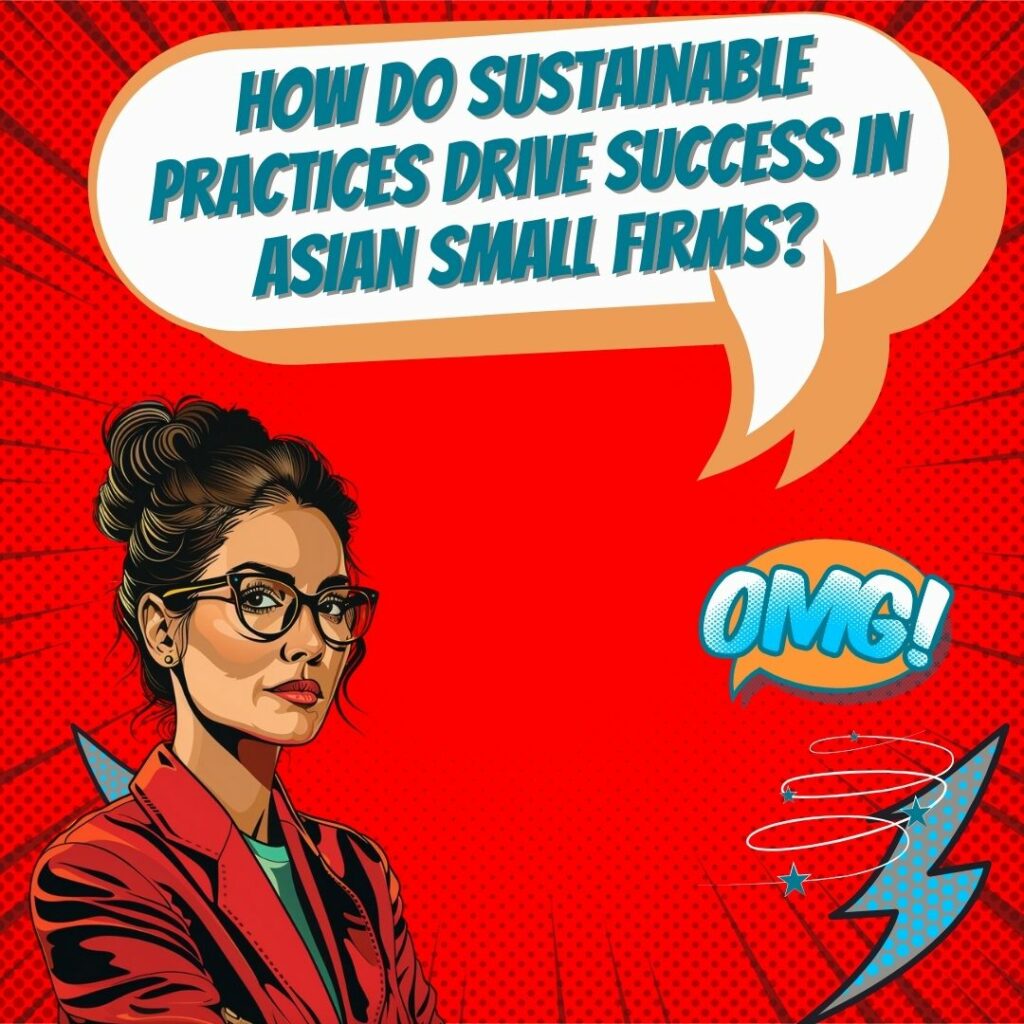Key Takeaways
✅ Overcoming Challenges and Leveraging Flexibility: Despite limited resources and information, SMEs in Asia can adapt swiftly to sustainable practices due to their smaller size. With support from organizations like the OECD and EBRD, they can access financial tools, training, and mentoring to turn these challenges into opportunities.
✅ Economic and Environmental Benefits: Sustainable practices not only boost profitability and reduce operating costs for SMEs but also save resources and energy. By offering eco-friendly products or services, SMEs can enhance their market reputation and attract customers who value sustainability.
✅ Access to Sustainable Financing and Partnerships: SMEs in Asia can tap into sustainable financing options to support their transition to green practices. This can include obtaining environmental certifications and investing in eco-friendly technologies. Adopting sustainability makes them appealing supply partners to larger corporations, opening doors to new business opportunities.

Introduction
Can small firms in Asia turn eco-friendly practices into a business advantage? As small and medium-sized enterprises (SMEs) are the backbone of Asia's economy, their environmental impact is vast. The need for sustainable practices has never been more urgent. Global green markets are estimated to reach $4 trillion to $5 trillion by 2030, and SMEs have the opportunity to seize a significant share. Aside from reducing their environmental footprint, adopting sustainable practices can result in increased profitability, competitiveness, and resilience.
However, challenges like limited resources and lack of information persist. This article explores the importance of green small firms in Asia, the innovative strategies they're using, and the benefits of going green. Convenient access to sustainable financing and partnerships is now within reach for SMEs. Stay tuned for actionable insights and groundbreaking information on leveraging sustainable practices for success.
Top Statistics
| Statistic | Insight |
|---|---|
| Addressable Market Size: The market size for green businesses in Asia is projected to reach between $4 trillion and $5 trillion by 2030. | This massive market potential underscores the growing importance of sustainable business opportunities in Asia, offering a lucrative market for green initiatives. |
| Investment Flows: On average, $9.2 trillion per year needs to be spent on physical assets for energy and land-use systems from 2020 to 2050, with an estimated $3.1 trillion of that in Asia. | The substantial investment required highlights the critical need for funding in sustainable infrastructure, driving green transformations across Asia. |
| Net-Zero Commitments: Over 15 countries and 670 companies in the Asia-Pacific (APAC) region have set or are committed to emission-reduction targets. | These commitments create new investment opportunities in green technology and emphasize the region's proactive stance towards sustainability. |
| SMEs in ASEAN: Small and Medium Enterprises (SMEs) make up 97-99% of businesses in the ASEAN member states and provide the majority of employment. | The dominance of SMEs in the employment sector makes their adoption of sustainable practices crucial for widespread environmental impact. |
| Renewable Energy: Asia plans to develop 45 GW of renewable energy production capacity, contributing to the region's green energy transition. | The focus on renewable energy projects signals a transformative shift towards reduced carbon footprints and long-term sustainability. |

Role of SMEs in Asia's Economy
Small and medium-sized enterprises (SMEs) play a vital role in Asia's economy, accounting for over 90% of businesses and contributing significantly to employment and GDP. Yet, the environmental impact of these companies cannot be ignored. For SMEs, adopting green practices may seem daunting, but the long-term benefits—such as increased profitability, competitiveness, and resilience—are too significant to overlook. SMEs are the backbone of local communities, driving economic growth and innovation across various sectors. Their adaptability and close customer relationships position them uniquely to lead in sustainable initiatives.
Challenges in Going Green for SMEs
SMEs often encounter numerous barriers when attempting to go green. Limited resources, both financial and human, can make sustainable investments seem out of reach. Lack of information and a short-term focus can further impede progress. To overcome these hurdles, policy approaches and financial tools tailored to SMEs' needs are essential. Governments and institutions must provide support systems that facilitate the transition to sustainability. Overcoming these challenges requires a coordinated effort between the public and private sectors, emphasizing education and accessible funding.
Green Business Opportunities in Asia
The market for green businesses in Asia is immense, projected to reach between $4 trillion to $5 trillion by 2030. Various sectors, from sustainable aviation fuel to renewable energy projects, are burgeoning. These initiatives serve not just as investment opportunities but as proof that sustainability is a profitable venture. Examples of successful projects abound, showcasing how green investments can yield a high return. Additionally, regional collaboration and technological advancements are accelerating the growth of green businesses, making the sector increasingly attractive.
Benefits of Sustainability for SMEs
For SMEs, sustainability offers a multitude of advantages. Sustainable practices can lead to cost savings through more efficient use of resources. Enhanced brand reputation can attract eco-conscious consumers, while new markets and funding sources become accessible. Integrating sustainability into business strategies and conducting sustainability assessments can help identify specific areas ripe for improvement, turning potential challenges into opportunities. Moreover, sustainable SMEs often experience increased employee satisfaction and loyalty, contributing to a more robust organizational culture.
Sustainable Financing Options for SMEs
Funding is a critical factor for SMEs aspiring to be green. Fortunately, various sustainable financing options exist, including green bonds, impact investing, and ESG-focused funding. Banks and organizations across Asia are increasingly supporting SMEs in their pursuit of sustainability by offering specialized financial products and services. These initiatives make it financially feasible for SMEs to invest in green technologies and practices. Access to these funding options can demystify the path to sustainability, providing SMEs with the resources needed to innovate and grow.
SMEs Embracing Sustainability in Asia
Examining real-life examples, we see numerous SMEs in Asia successfully adopting sustainable practices. Take, for instance, the Bel-Tam yurt camp in the Kyrgyz Republic and Tach Hil in Turkmenistan. These businesses have embraced environmental sustainability with open arms. Both have benefited not only from cost savings and increased revenues but also from the support of organizations like the European Bank for Reconstruction and Development (EBRD). Their stories highlight the tangible benefits of going green, inspiring other SMEs to follow suit and prioritize sustainability.
AI Marketing Engineers Recommendation
Recommendation 1: Harness Data Analytics for Optimal Resource Management: By embracing data analytics, green small firms can track their resource usage with precision. According to a report by McKinsey, businesses employing advanced analytics techniques observe a 15-20% reduction in energy costs. Implementing data-driven insights helps firms minimize waste and streamline operations, proving that sustainability and cost-efficiency can go hand-in-hand.
Recommendation 2: Leverage Local Sustainable Practices: Current trends show that local sourcing is becoming increasingly important. The Asia-Pacific region has seen a 30% increase in consumers demanding locally-sourced products, as noted in a Nielsen survey. Green small firms should build strong relationships with local suppliers practicing sustainability. This strategy not only boosts the local economy but also reduces the carbon footprint associated with long-distance transportation.
Recommendation 3: Implement Smart Technology Solutions: Smart technologies like IoT (Internet of Things) devices and AI-driven automation tools can significantly enhance operational efficiency. A study by Deloitte highlights that IoT implementation can lead to 50% improvements in efficiency and productivity. By adopting IoT for real-time monitoring and AI for predictive maintenance, green small firms in Asia can achieve unparalleled efficiencies, proving that sustainability can scale with the right tools in place.
Relevant Links
- Explore How to Drive Market Penetration
- Learn How User Behavior Can Enhance Marketing
- Discover Personalized Advertising Benefits
- Unlock the Power of Financial Insights
- Boost Your Advertising ROI
 Conclusion
Conclusion
Green small firms in Asia are proving that sustainable practices can lead to significant success. Despite the challenges of limited resources and lack of information, various policy approaches and financial tools can help SMEs overcome these hurdles. The market for green businesses in Asia is enormous, estimated to be worth $4 trillion to $5 trillion by 2030, offering vast opportunities for growth. Sustainable practices not only enhance profitability and brand reputation but also open up new markets and funding sources.
Through sustainable financing options like green bonds and impact investing, SMEs can access the necessary funds to implement green technologies. Case studies such as Bel-Tam yurt camp and Tach Hil showcase the tangible benefits of going green and the support available from organizations like the EBRD. By integrating sustainability into their core business strategies, SMEs in Asia can position themselves for long-term success and resilience in an increasingly eco-conscious world. The future of Asian SMEs lies in their ability to innovate and adopt sustainable practices that drive not just economic but also environmental progress.
FAQs
Question 1: What is the significance of sustainability in small firms in Asia?
Answer: Sustainability is crucial for small firms in Asia as it helps them reduce environmental impact, improve social responsibility, and enhance governance practices, leading to long-term success and competitiveness.
Question 2: What are the key drivers of sustainability in small firms in Asia?
Answer: Key drivers include consumer demand for sustainable products, government regulations, and the need to reduce operational costs and improve brand reputation.
Question 3: What are the main challenges faced by small firms in Asia in adopting sustainable practices?
Answer: Challenges include limited resources, lack of expertise, and high upfront costs associated with implementing sustainable practices.
Question 4: How can small firms in Asia measure and report their sustainability performance?
Answer: Small firms can use tools like the SME360X digital assessment tool to measure and benchmark their environmental impact and report their sustainability performance.
Question 5: What role do business schools play in promoting sustainability in small firms in Asia?
Answer: Business schools can help by upskilling leadership talent, collaborating with governments, and presenting sustainability as an opportunity for growth.
Question 6: How can small firms in Asia access funding for sustainable initiatives?
Answer: Small firms can access funding through programs like the Small Business Impact Fund (SBIF) and other initiatives that support green business growth.
Question 7: What are some practical steps small firms in Asia can take to start their sustainability journey?
Answer: Practical steps include conducting environmental impact assessments, setting sustainability goals, and implementing energy-efficient practices.
Question 8: How can small firms in Asia engage with stakeholders to promote sustainability?
Answer: Small firms can engage with stakeholders through open communication, collaboration, and education on the benefits of sustainability.
Question 9: What are some successful examples of small firms in Asia that have adopted sustainable practices?
Answer: Examples include Bel-Tam yurt camp in the Kyrgyz Republic, which has transitioned to ecotourism, and Tach Hil in Turkmenistan, which has expanded its operations through improved ESG reporting and renewable energy solutions.

Academic References
- McKinsey & Company. (2022). Net-zero emissions: Asia’s green/economic revolution. McKinsey Global Institute. This report highlights the significant market opportunity for green businesses in Asia, with an expected addressable market size of $4 trillion to $5 trillion by 2030. It emphasizes the need for businesses to deploy climate technologies to meet the net-zero challenge.
- Asian Development Bank. (2016). Green Business Opportunities and Challenges in Asia and the Pacific. Asian Development Bank Institute. This paper discusses the opportunities and challenges for green businesses in Asia and the Pacific, including the need for governments to introduce policies and regulations to mainstream sustainable approaches to consumption and production.
- OECD. (2021). Facilitating the Green Transition for ASEAN Small and Medium-sized Enterprises (SMEs). Organisation for Economic Co-operation and Development. This report emphasizes the importance of facilitating the green transition for ASEAN SMEs, highlighting the benefits of adopting greener practices such as increased profitability, competitiveness, and resilience, as well as the challenges faced by SMEs in adopting these practices.






